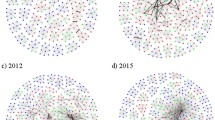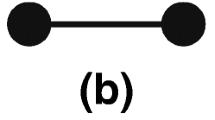Abstract
The concept of motifs provides a new perspective for studying local patterns, which is useful for understanding the nature of a network structure. In this study, the types and evolution of the motifs of the shareholder co-ownership network, constructed based on common shareholding data from 2007 to 2017, are explored from a micro-perspective. Although with a low proportion, the closed motifs were found to be important motifs with statistical significance in the network. Furthermore, the motifs containing financial investment company shareholders tend to disappear on both short (quarterly) and long (annual) time scales. In contrast, the motifs containing general corporate shareholders tend to remain unchanged. Finally, the abnormal abrupt changes in the proportions of important motifs in the real network relative to the random network before and after the financial crisis are calculated. The number of Motif 4 containing state-owned companies, general companies, and individual investors decreases abnormally during the financial crisis. This research is of great significance for understanding information interaction among multiple investors.









Similar content being viewed by others
Notes
Lifting the sedan chair, a proprietary term in the stock market, refers to the fact that the buyer anticipates that a certain stock will rise, and therefore buys a large amount of stock, which leads to an increase in the stock price. But the result is that other people (generally referred to as the banker) sell at a high position and make a profit, and eventually the buyer is locked up.
The 3-node motif structure is the most common subgraph form in the network [7]. If the number of nodes is less than 3, there are too few subgraph types, which is not conducive to mining local information of the network. If there are too many nodes, the number of possible motif structures increases exponentially, which increases the complexity of motif recognition. At the same time, the motif structure of more than 4 nodes can be generated by the superposition and combination of different 3-node motif structures. In a word, the 3-node motif structure can satisfy the mining of local features of the network. The "motif structure" in this study refers to the "3-node motif structure" unless otherwise specified.
The important motif structure is a subset of the motif structure, which refers to the motif structure whose proportion in the real network is significantly higher than that in the random network.
As of the end of 2006, 1301 companies had completed the split share reform, accounting for 97% of the total number of listed companies. In order to exclude the influence of shareholder structure and equity nature on the results, the starting point of the data in this paper is the first quarter of 2007.
The CSI 300 index consists of 300 of the largest and most liquid A-shares. The index is designed to reflect the overall performance of China’s A-share market.
The number of random network in this paper is 1000.
References
Hong, H., Kubik, J.D., Stein, J.C.: Thy neighbor’s portfolio: word-of-mouth effects in the holdings and trades of money managers. J. Finance 60(6), 2801–2824 (2005)
Shue, K.: Executive networks and firm policies: evidence from the random assignment of MBA peers. Rev. Financ. Stud. 26(6), 1401–1442 (2013)
Fracassi, C.: Corporate finance policies and social networks. Manag. Sci. 63(8), 2420–2438 (2017)
Li, H., An, H., Huang, J., Huang, X., et al.: The evolutionary stability of shareholders’ co-holding behavior for China’s listed energy companies based on associated maximal connected sub-graphs of derivative holding-based networks. Appl. Energy 162, 1601–1607 (2016)
Crane, A.D., Koch, A., Michenaud, S.: Institutional investor cliques and governance. J. Financ. Econ. 133(1), 175–197 (2019)
Pareek, A.: Information networks: implications for mutual fund trading behavior and stock returns. Working paper (2012)
Milo, R., Shen-Orr, S., Itzkovitz, S., Kashtan, N., et al.: Network motifs: simple building blocks of complex networks. Science 298(5594), 824–827 (2002)
Guan, Q., An, H., Liu, N., An, F., et al.: Information connections among multiple investors: evolutionary local patterns revealed by motifs. Sci. Rep. 7, 14034 (2017)
Battiston, S., Farmer, J.D., Flache, A., Garlaschelli, D., et al.: Complexity theory and financial regulation. Science 351(6275), 818–819 (2016)
Lee, T.I., Rinaldi, N.J., Robert, F., Odom, D.T., et al.: Transcriptional regulatory networks in Saccharomyces cerevisiae. Science 298(5594), 799–804 (2002)
Harrigan, N., Achananuparp, P., Lim, E.P.: Influentials, novelty, and social contagion: the viral power of average friends, close communities, and old news. Soc. Netw. 34(4), 470–480 (2012)
Kovanen, L., Kaski, K., Kertesz, J., Saramaki, J.: Temporal motifs reveal homophily, gender-specific patterns, and group talk in call sequences. Proc. Natl. Acad. Sci. 110(45), 18070–18075 (2013)
Jiang, Z.Q., **e, W.J., **ong, X., Zhang, W., et al.: Trading networks, abnormal motifs and stock manipulation. Quant. Finance Lett. 1(1), 1–8 (2013)
Squartini, T., Lelyveld, I., Garlaschelli, D.: Early-warning signals of topological collapse in interbank networks. Sci. Rep. 3, 3357 (2013)
Bargigli, L., Di Iasio, G., Infante, L., Lillo, F., et al.: The multiplex structure of interbank networks. Quant. Finance 15(4), 673–691 (2015)
Takes, F.W., Kosters, W.A., Witte, B., et al.: Multiplex network motifs as building blocks of corporate networks. Appl. Netw. Sci. 3(1), 39 (2018)
Liu, S., Huang, S., Chi, Y., Feng, S., et al.: Three-level network analysis of the North American natural gas price: a multiscale perspective. Int. Rev. Financ. Anal. 67, 101420 (2020)
Bargigli, L., Gallegati, M.: Random digraphs with given expected degree sequences: a model for economic networks. J. Econ. Behav. Organ. 78, 396–411 (2011)
Veld, D.I., Lelyveld, I.: Finding the core: network structure in interbank markets. J. Bank. Finance 49, 27–40 (2014)
Nobi, A., Lee, S., Kim, D.H., Lee, J.W.: Correlation and network topologies in global and local stock indices. Phys. Lett. A 378, 2482–2489 (2014)
Minoiu, C., Kang, C., Subrahmanian, V.S., Berea, A.: Does financial connectedness predict crises? Quant. Finance 15(4), 607–624 (2015)
Samitas, A., Kampouris, E., Kenourgios, D.: Machine learning as an early warning system to predict financial crisis. Int. Rev. Financ. Anal. 71, 101507 (2020)
Li, S., Wang, C.: Network structure, portfolio diversification and systemic risk. J. Manag. Sci. Eng. 6(2), 235–245 (2021)
Saracco, F., Clemente, R.D., Gabrielli, A., Squartini, T.: Detecting early signs of the 2007–2008 crisis in the world trade. Sci. Rep. 6, 30286 (2016)
Park, J., Newman, M.E.: Statistical mechanics of networks. Phys. Rev. E 70, 066117 (2004)
Garlaschelli, D.: The weighted random graph model. New J. Phys. 11, 073005 (2009)
Squartini, T., Garlaschelli, D.: Analytical maximum-likelihood method to detect patterns in real networks. New J. Phys. 13, 083001 (2011)
Squartini, T., Fagiolo, G., Garlaschelli, D.: Randomizing world trade. II. A weighted network analysis. Phys. Rev. E 84, 046118 (2011)
Garlaschelli, D., Loffredo, M.I.: Generalized Bose-Fermi statistics and structural correlations in weighted networks. Phys. Rev. Lett. 102, 038701 (2009)
Roberts, E.S., Coolen, A.C.C.: Unbiased degree-preserving randomization of directed binary networks. Phys. Rev. E 85, 046103 (2012)
Mastrandrea, R., Squartini, T., Fagiolo, G., Garlaschelli, D.: Enhanced reconstruction of weighted networks from strengths and degrees. New J. Phys. 16, 043022 (2014)
Li, J., Zhang, Y., Feng, X., An, Y.: Which kind of investor causes comovement? J. Int. Finan. Mark. Inst. Money 61, 1–15 (2019)
Newman, M.E.: Scientific collaboration networks. I. Network construction and fundamental results. Phys. Rev. E 64(1), 016131 (2001)
Khan, N.S., Kumam, P., Thounthong, P.: Computational approach to dynamic systems through similarity measure and homotopy analysis method for renewable energy. Curr. Comput.-Aided Drug Des. 10, 1086 (2020)
Khan, N.S., Kumam, P., Thounthong, P.: Magnetic field promoted irreversible process of water based nanocomposites with heat and mass transfer flow. Sci. Rep. 11, 1692 (2021)
Killworth, P.D., Bernard, H.R.: Informant accuracy in social network data. Hum. Organ. 35(3), 269–286 (1976)
Pajek datasets http://vlado.fmf.uni-lj.si/pub/networks/data/bio/foodweb/foodweb.htm
Li, X., Sun, M., Boersma, K.: Policy spillover and regional linkage characteristics of the real estate market in China’s urban agglomerations. J. Manag. Sci. Eng. 4(3), 189–210 (2019)
Dow, J., Gorton, G.: Stock market efficiency and economic efficiency: Is there a connection? J. Finance 52(3), 1087–1129 (1997)
Acknowledgements
This article is funded by the National Natural Science Foundation of China (U1811462, 71771170, 71790594), Youth Foundation for Humanities and Social Sciences Research of the Ministry of Education (20YJC790062), Open Project of Jiangsu Key Laboratory of Financial Engineering (NSK2021-18), Jiangsu Planning Office of Philosophy and Social Science (20GLC007) and the Applied Economics of Nan**g Audit University of the Priority Academic Program Development Phase III of Jiangsu Higher Education Institutions (Office of Jiangsu Provincial People’s Government, No. [2018]87).
Funding
This article is funded by the National Natural Science Foundation of China (U1811462, 71771170, 71790594), Youth Foundation for Humanities and Social Sciences Research of the Ministry of Education (20YJC790062), Open Project of Jiangsu Key Laboratory of Financial Engineering (NSK2021-18), Jiangsu Planning Office of Philosophy and Social Science (20GLC007) and the Applied Economics of Nan**g Audit University of the Priority Academic Program. Development Phase III of Jiangsu Higher Education Institutions (Office of Jiangsu Provincial People’s Government, No. [2018]87).
Author information
Authors and Affiliations
Corresponding author
Ethics declarations
Conflict of interest
The authors declare that the research was conducted in the absence of any commercial or financial relationships that could be constructed as a potential conflict of interest. The authors have no affiliation with any organization with a direct or indirect financial interest in the subject matter discussed in the manuscript.
Data availability
The authors confirm that data will be made available on reasonable request.
Additional information
Publisher's Note
Springer Nature remains neutral with regard to jurisdictional claims in published maps and institutional affiliations.
Appendix
Rights and permissions
About this article
Cite this article
Li, J., Zhang, Y. & Wang, L. Information transmission among multiple investors: a micro-perspective revealed by motifs. Nonlinear Dyn 108, 2833–2850 (2022). https://doi.org/10.1007/s11071-022-07307-8
Received:
Accepted:
Published:
Issue Date:
DOI: https://doi.org/10.1007/s11071-022-07307-8




